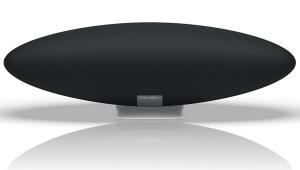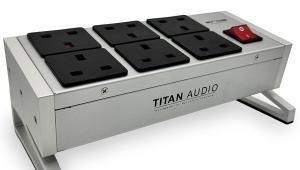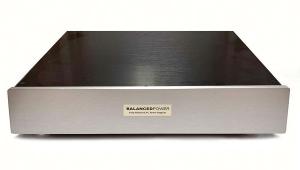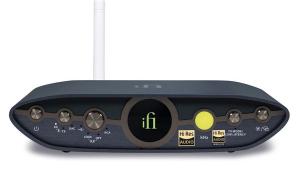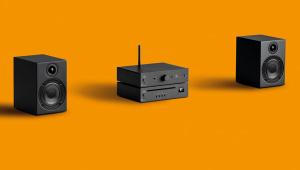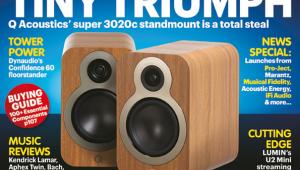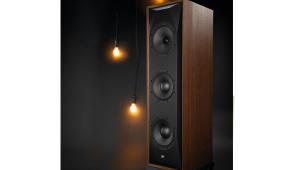Marantz SACD 30n

 What we have here is no less than a reinvention. No, the famous Marantz: “Because music matters” line hasn’t been put out to pasture, but the new one puts these latest arrivals in context: this, we’re told, is: “Modern Musical Luxury”.
What we have here is no less than a reinvention. No, the famous Marantz: “Because music matters” line hasn’t been put out to pasture, but the new one puts these latest arrivals in context: this, we’re told, is: “Modern Musical Luxury”.
Drawing on and updating the style of classic models from the past, including the original Audio Consolette and the Model 30 of the early seventies, the new arrivals’ industrial design is a long way from the existing Marantz look.
Both models have their controls on a ‘sub-fascia’ standing proud of the main casework, which has a machined finish – a style we’re told will percolate its way down through the range in the fullness of time. Indeed, even the model-naming speaks to this Marantz reset: in the past, this would have been the SA-30n and PM-30.
What the SACD 30n delivers is what the company’s ND8006 (HFC 450)promised but never quite achieved, which was to be all the digital source anyone could ever need. The ND8006, launched at £1,200, is almost there with its network playback, USB DAC functionality, USB DAC facility and CD playback, but this is the first time it’s all come together, courtesy of a dedicated SACD/CD transport mechanism.
It’s pretty much on the money when it comes to futureproofing, too, accepting file formats all the way up to 32-bit/384kHz PCM and DSD256 via USB and 24-bit/192kHz and DSD128 from network sources such as a NAS unit. Streaming capability includes the likes of Amazon Music HD, Spotify and Tidal, both Bluetooth and Apple AirPlay2 are built-in, and the Heos implementation brings both multi-room capability and the ability for some functions to be accessed by voice control using Amazon Alexa or Google Assistant.
Like the amplifier, the SACD 30n has been: “Tuned with passion by the Marantz Sound Master”, with familiar company elements here including the use of a hefty toroidal transformer, customised components in the signal path and – of course – Hyper-Dynamic Amplifier Modules (HDAMs), which are miniature amplifiers built from discrete components and used where lesser designs might use ‘amp-on-a-chip’ solutions.
In addition to network connectivity and USB-B, the SACD 30n has two optical digital inputs and one coaxial, plus a USB-A port for memory devices, while outputs run to one digital of each flavour, fixed and variable analogue outs – so it can be used straight into a power amp – and a dedicated headphone amplifier with its own volume control. But the really clever stuff is in its digital-to-analogue conversion, or rather lack thereof (in the strictest sense): like other upmarket Marantz player/DACs of late, this one uses Marantz Musical Mastering (MMM)to upconvert all digital signals to DSD128 (with selectable digital filters for all but SACD), then converts it for analogue output using nothing more complex than a low-pass filter. As has been a Marantz mantra for a while, DSD actually is analogue – or at least a direct analogue of the audio waveform, thanks to its single bit/ultra-high sampling rate technology.
This MMM design has stood Marantz in good stead since it was launched in the SA-10 flagship ‘player with DAC’ a few years back, and the 30 Series also follows the company’s familiar pattern by leaving all the digital trickery in the hands of the source component here, and going for an all-analogue-input design. So this amp, quoted at 100W output into 8ohm, doubling into 4ohm, has five line inputs plus MM/MC phono, along with line out and pre-outs and a direct power amp input – handy for use with an AV processor, for example. Outputs run to one set of speakers – the rear panel here isn’t exactly crowded – and a headphone socket – and the phono and CD inputs are treated to more substantial sockets than those used for the other line-ins. However, there’s no balanced connectivity here, as Marantz doesn’t feel it offers any benefit in products such as this, and the relatively short interconnect runs likely to be used.
The amplifier uses separate power supplies for the preamp and power amp sections, right back to the mains input: a toroidal transformer in its own double shield feeds the preamp, which uses those Marantz HDAMs again, while the phono section is the company’s Marantz Musical Premium Phono EQ design, combining more HDAMs with JFETs, and having a front-panel selector with three-stage impedance selection for optimal matching with MC cartridges. Tone and balance controls are also provided.
The power amp, meanwhile, uses the same Hypex switching-mode technology found in the likes of the PM-10 and PM-12SE amplifiers, together with a power supply designed for instantaneous high-current delivery.
But here we come to the modern, musical and luxurious elephant in the room: the 30 Series may be new, but what’s under the hood – especially of the Model 30 amplifier – is not just familiar, but almost identical to the layout you’ll find in the company’s 12SE series. That, in turn, means like the KI Ruby products the company launched a couple of years ago. And with the closeness of pricing between the 12SEs and the 30 Series – £3,000 per unit plays £2,700 here – surely that’s going to spread some confusion?
I put this question to Marantz Senior Acoustics Engineer Europe, Rainer Finck, just a few weeks after the announcement of the 12SEs and he admitted that: “Some consumers will find the 30 models more attractive”. He wasn’t talking about the styling, however excited Marantz is about it, but the feature-set of the SACD 30n – and I think he’s bang on the money. With its combination of SACD/CD playback, DAC functionality, network streaming and Heos, this is a more fully formed machine for modern music needs.
There’s nothing wrong at all with this kind of platform-sharing – think of the variety of VWs, Audis, Skodas and Seats all sitting on the same underpinnings, not to mention the fact that at least one hi-fi conglomerate seems currently to be selling at least three brands with some nifty reskinning of the same technology – and the upside of it here is that, while the looks may be different, what you’re getting is the well-developed, reliable and highly involving Marantz sound, whether you play LPs, SACDs or your favourite tunes from network storage.
Sound quality
That’s a very good thing indeed: what Marantz has always majored on is all that hi-fi cleverness going on below the surface, while the presentation glides serenely from the speakers, and that’s as true whether you ask this duo to crash out some rock or pop, or play close-detailed jazz or classical music. The sound has a warmth and generosity that’s hard not to like, without becoming over lush and cloying, thanks to a sparkling and airy midband and treble that really bring out the ambience and atmosphere of recordings.
That allows it to deliver remarkable presence with Emily Barker’s A Dark Murmuration Of Words set, with its stripped-back instrumentation, or to slam through the 2020 remaster of The Stones’ Doo Doo Doo Doo (Heartbreaker) from Goats Head Soup, with its chopping guitars, ripe brass and backing vocals and plaintive guitar solo. There’s exceptional clarity here, but never any sense that it’s being forced on you, so well integrated is the sound.
Used with speakers not exactly known for being bass-shy – in this case an elderly PMC OB1 and Neat’s Iota Xplorer (HFC 435), using transmission-line and isobaric bass architecture respectively, the Model 30 shows its ability to not just deliver a lot of bass, but also start and stop it smartly, while the amp is just as impressive with LPs spun in through that phono stage as it is with multi-DSD content streamed from network storage.
Conclusion
This combination may not be quite as new as it would initially appear, but it makes a fine job of taking established building blocks and sonic traits, and reworking them for what will hopefully be a new generation of Marantz buyers. AE
DETAILS
Product: Marantz SACD 30n
Type: SACD/network player/DAC
FEATURES
● File formats up to: 32-bit/384kHz and DSD256
● Inputs: USB-B; 2x optical; 1x coaxial
● Networking: wi-fi; Ethernet; Bluetooth; AirPlay2; Heos
 |
Inside this month's issue:
Ruark R610 music system and Sabre-R standmount speakers, PMC twenty.23i Active, floorstanders, English Acoustics Downton preamplifier, Bluesound NODE ICON preamp/streamer, Ortofon Concorde Music Blue MM cartridge and much, much more
|
















